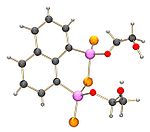
Naphthalen-1,8-diyl 1,3,2,4-dithiadiphosphetane 2,4-disulfide
Encyclopedia
A compound related to Lawesson's reagent
named NpP2S4 has been formed by the reaction of 1-bromonaphthalene
with P4S10, this is a 1,3,2,4-dithiadiphosphetane 2,4-disulfide which has a naphth-1,8-diyl group holding the two phosphorus
atoms together. The mechanism by which the NpP2S4 forms is unclear, but it is thought to occur through some free radical
process, and naphthalene
has been detected as a side product in its synthesis. In general NpP2S4 has been found to be less reactive than Lawesson's reagent, this result agrees with the hypothesis
that the dithiophosphine ylide
s are responsible for the majority of the chemical reactions of the 1,3,2,4-dithiadiphosphetane 2,4-disulfides.
It has been found that NpP2S4 reacts with many hydroxyl compounds, for instance methanol
, ethylene glycol
and a catechol to form species with oxygen
atoms bonded to the phosphorus atoms.
Methanol reacts to form compound which has one O-methyl and one S-methyl bonded to the two phosphorus atoms.
Lawesson's reagent
Lawesson's reagent, or LR, is a chemical compound used in organic synthesis as a thiation agent. Lawesson's reagent was first made popular by Sven-Olov Lawesson, who did not, however, invent it. Lawesson's reagent was first made in 1956 during a systematic study of the reactions of arenes with...
named NpP2S4 has been formed by the reaction of 1-bromonaphthalene
Naphthalene
Naphthalene is an organic compound with formula . It is a white crystalline solid with a characteristic odor that is detectable at concentrations as low as 0.08 ppm by mass. As an aromatic hydrocarbon, naphthalene's structure consists of a fused pair of benzene rings...
with P4S10, this is a 1,3,2,4-dithiadiphosphetane 2,4-disulfide which has a naphth-1,8-diyl group holding the two phosphorus
Phosphorus
Phosphorus is the chemical element that has the symbol P and atomic number 15. A multivalent nonmetal of the nitrogen group, phosphorus as a mineral is almost always present in its maximally oxidized state, as inorganic phosphate rocks...
atoms together. The mechanism by which the NpP2S4 forms is unclear, but it is thought to occur through some free radical
Radical (chemistry)
Radicals are atoms, molecules, or ions with unpaired electrons on an open shell configuration. Free radicals may have positive, negative, or zero charge...
process, and naphthalene
Naphthalene
Naphthalene is an organic compound with formula . It is a white crystalline solid with a characteristic odor that is detectable at concentrations as low as 0.08 ppm by mass. As an aromatic hydrocarbon, naphthalene's structure consists of a fused pair of benzene rings...
has been detected as a side product in its synthesis. In general NpP2S4 has been found to be less reactive than Lawesson's reagent, this result agrees with the hypothesis
Hypothesis
A hypothesis is a proposed explanation for a phenomenon. The term derives from the Greek, ὑποτιθέναι – hypotithenai meaning "to put under" or "to suppose". For a hypothesis to be put forward as a scientific hypothesis, the scientific method requires that one can test it...
that the dithiophosphine ylide
Ylide
An ylide or ylid is a neutral dipolar molecule containing a formally negatively charged atom directly attached to a hetero atom with a formal positive charge , and in which both atoms have full octets of electrons. Ylides are thus 1,2-dipolar compounds...
s are responsible for the majority of the chemical reactions of the 1,3,2,4-dithiadiphosphetane 2,4-disulfides.
It has been found that NpP2S4 reacts with many hydroxyl compounds, for instance methanol
Methanol
Methanol, also known as methyl alcohol, wood alcohol, wood naphtha or wood spirits, is a chemical with the formula CH3OH . It is the simplest alcohol, and is a light, volatile, colorless, flammable liquid with a distinctive odor very similar to, but slightly sweeter than, ethanol...
, ethylene glycol
Ethylene glycol
Ethylene glycol is an organic compound widely used as an automotive antifreeze and a precursor to polymers. In its pure form, it is an odorless, colorless, syrupy, sweet-tasting liquid...
and a catechol to form species with oxygen
Oxygen
Oxygen is the element with atomic number 8 and represented by the symbol O. Its name derives from the Greek roots ὀξύς and -γενής , because at the time of naming, it was mistakenly thought that all acids required oxygen in their composition...
atoms bonded to the phosphorus atoms.
Methanol reacts to form compound which has one O-methyl and one S-methyl bonded to the two phosphorus atoms.
 |
 |
 |

